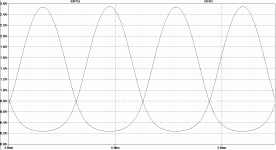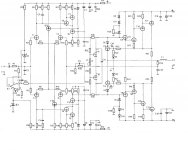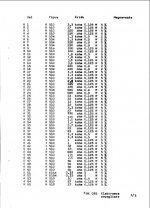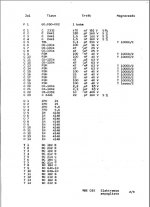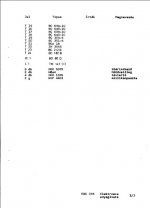Hi all,
Which do you prefer and why? On paper the sziklai pair is superior - lower distortion, fewer high order harmonics and better temperature stability. However, in real life the driver transistor of the sziklai pair can oscillate on switch off requiring compensation capacitors and perhaps degrading sonics.
Theory aside, what do you prefer in a practical circuit and why?
Look forward to your thoughts!
Which do you prefer and why? On paper the sziklai pair is superior - lower distortion, fewer high order harmonics and better temperature stability. However, in real life the driver transistor of the sziklai pair can oscillate on switch off requiring compensation capacitors and perhaps degrading sonics.
Theory aside, what do you prefer in a practical circuit and why?
Look forward to your thoughts!
Its easy enough to make a non-switching output stage that always maintains
a hundred or so milliamps in bypass of the load. CFP would never need to see
the "driver switch off" condition you so worried about.
I prefer Aleph (BJT MOSFET) or Allison (BJT BJT) super pair for my outputs.
1st BJT turned backwards (emitter coupled) as a depletion mode vreference.
a hundred or so milliamps in bypass of the load. CFP would never need to see
the "driver switch off" condition you so worried about.
I prefer Aleph (BJT MOSFET) or Allison (BJT BJT) super pair for my outputs.
1st BJT turned backwards (emitter coupled) as a depletion mode vreference.
Last edited:
I could easily make these curves cross a lot lower. if you need to
see them squashed flatter against the 200mA reserve current...
Is it AB or Aa? Hard to tell from this graph of transistor currents.
But if you were to look at my Schottky diodes, you then see AB!
Only diodes without recovery probs turn off, transistors never...
AB like this would not bother your siziklai pairs...
see them squashed flatter against the 200mA reserve current...
Is it AB or Aa? Hard to tell from this graph of transistor currents.
But if you were to look at my Schottky diodes, you then see AB!
Only diodes without recovery probs turn off, transistors never...
AB like this would not bother your siziklai pairs...
Attachments
Member
Joined 2009
Paid Member
You should read more from Doug Self on CFP output for some of the subtleties. For example, although thermal runaway is less of an issue because the drivers have firm control over the outputs, the optimal Class AB bias current (temperature dependent) needs to be controlled much more accurately than regular EF output, for minimum distortion.
And I think Doug found that low signal level distortion for CFP was worse than for EF even though large signal linearity favours the CFP. I believe the reason is that the change in gain around cross-over is more abrupt than EF.
So my take on it is use CFP for Class A only, such as the drivers to an EF stage like the Roender amplifier - or you need some kind of adaptive bias as Kenpeter shows.
And I think Doug found that low signal level distortion for CFP was worse than for EF even though large signal linearity favours the CFP. I believe the reason is that the change in gain around cross-over is more abrupt than EF.
So my take on it is use CFP for Class A only, such as the drivers to an EF stage like the Roender amplifier - or you need some kind of adaptive bias as Kenpeter shows.
to the same topic also this thread exists:
http://www.diyaudio.com/forums/solid-state/92412-why-collector-drain-output-stages-so-rare.html
by my post #59 are additional URLs for more informations.
Go also to
http://www.diyaudio.com/forums/solid-state/41034-abacus-rieder-60-120-amplifier.html
http://www.diyaudio.com/forums/solid-state/92412-why-collector-drain-output-stages-so-rare.html
by my post #59 are additional URLs for more informations.
Go also to
http://www.diyaudio.com/forums/solid-state/41034-abacus-rieder-60-120-amplifier.html
Last edited:
Does anyone have any thoughts on which topology would be preferable for highly biased class AB, say 0.5A of bias?
Hi
why not AC class,
it has lower distortion than AB...
CCDA & Class-AC
MY 2 CENTS ...
i will say that fact number one when it comes to high power >100W and more than 2 pairs sziklai will be difficult to stabilize .. many of pro amplifiers that were based on this philosophy in long run failed
now ...listening impressions will be that sziklai is more musical while EFP is more accurate ...now what is wrong from theory approach and responsible for this behavior and secondly what is correct and what not is up to u to define .
to sumarize i could say that for low power domestic casual listening the sziklai if builted properly is unbetable ( class AB fairly high biased >50 -<200
for higher power it has to be EFP
Kind regards sakis
i will say that fact number one when it comes to high power >100W and more than 2 pairs sziklai will be difficult to stabilize .. many of pro amplifiers that were based on this philosophy in long run failed
now ...listening impressions will be that sziklai is more musical while EFP is more accurate ...now what is wrong from theory approach and responsible for this behavior and secondly what is correct and what not is up to u to define .
to sumarize i could say that for low power domestic casual listening the sziklai if builted properly is unbetable ( class AB fairly high biased >50 -<200
for higher power it has to be EFP
Kind regards sakis
Hello,
Maybe a little OFF, here is a schematic of a hungarian active studio monitor's amplifier, it uses triple Sziklai transistors on the output, what do you think about it? Do you think it is worth a try to rebuild? it should sound nice.
Maybe a little OFF, here is a schematic of a hungarian active studio monitor's amplifier, it uses triple Sziklai transistors on the output, what do you think about it? Do you think it is worth a try to rebuild? it should sound nice.
Attachments
Hello,
Maybe a little OFF, here is a schematic of a hungarian active studio monitor's amplifier, it uses triple Sziklai transistors on the output, what do you think about it? Do you think it is worth a try to rebuild? it should sound nice.
first transistor and second transistor from the Sziklai darlington here consist of a normal darlington. The goal is the same as by the Quad 303 and others:
the least possible effect on the VAS at high current flows through the output in the load.
About
http://www.diyaudio.com/forums/solid-state/113943-quad-303-triple-cascade.html
you will find more topologies with that goal.
What is the model and brand name of that monitor?
A amplifier with only 2 output devices was published in the GDR-magazine Radio Fernsehen Elektronic, 11/1977.Wow, what a fascinating concept. Can you point me in the direction of any amplifier circuits that use this idea?
.
Does anyone have any thoughts on which topology would be preferable for highly biased class AB, say 0.5A of bias?
I have had very good results from Sziklai pair. Lower over-all amp distortion (20dB lower) is result over a regular e-follower.
THx-RNMarsh
Last edited:
- Status
- This old topic is closed. If you want to reopen this topic, contact a moderator using the "Report Post" button.
- Home
- Amplifiers
- Solid State
- Darlington or Sziklai (compound) pair output stages?
